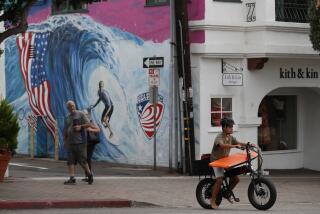Running Wild
They donned gay apparel, blew whistles, sounded horns and raised their voices like cacophonous choirs of not-so-heavenly hosts. They slalomed through the crowds that packed the shopping malls of Costa Mesa. It was the first day of winter and the last shopping weekend before Christmas, but it was the same ol’ same ol’ for the Hash House Harriers.
“We came to a big shopping district and dressed this way because it’s December,” said a man whose fluffy red-and-white stocking cap was stuffed so that it pointed straight up like a dunce cap. “We wanted to spread holiday goodwill and Christmas spirit. Also, we wanted to create a little pandemonium.”
Except for the details of their costumes, props and poses--a man wearing antlers sang an adapted version of “Silent Night” while carrying a Christmas tree fashioned from a toilet plunger, complete with battery-operated blinking lights--it could have been any Hash House Harriers event at any time of year. For hashers, as they call themselves, ‘tis always the season to be a little too jolly.
“Hashing is what it is--organized anarchy,” said a veteran hasher, whose headdress and sunglasses and attitude cast him as a cross between one of the Three Wise Men and a Middle Eastern arms dealer. “It’s loaded with tradition, but in a free-form sort of way.”
*
A run with the Hash House Harriers derives from the stupid-human-tricks school of fun and games. Once a week they gather somewhere--could be anywhere--with noisemakers and name tags and chunks of chalk and bags of flour to chase one another for several miles in a wacky version of the old English game of Hounds and Hares. The hare or hares (usually one or two) get a 15-minute head start and lay a trail of chalk and flour to mark their path. Then the hounds set off, following the markings and trying to catch them.
A code, from symbols written on the ground to toots on whistles to shouted words, enables the hashers to communicate as they frenetically try to follow the trail and catch the hares before they reach their destination, usually after a run of three to six miles, which can take an hour or more. The hare picks the course several weeks in advance, and meeting places are announced in a weekly newsletter.
The appeal is based on the same embarrassment-is-beautiful philosophy that at this time of year translates into the popularity of impromptu caroling and last-minute shopping. Or, for that matter, chug-a-lugging holiday spirit--another significant part of the Hash House Harriers experience. At the finish line, they drink beer and sing songs in kangaroo court fashion, .
Some of the 107 men and women (a typical number) who participated Sunday noted with a certain reverence that the course--which began in the parking lot at the Metro Pointe shopping center in Costa Mesa and concluded in a park across the street from the Trinity Broadcasting Network and its Gold, Frankincense & Myrrh Gift Shop--encapsulated various meanings of the season.
Still, one veteran hasher said, “During the heat of summer, 300 of us go to San Diego and run down the streets in red dresses. Except for how much we sweat, that’s not much different from this.”
The color scheme was certainly similar. Red was easily the most popular sartorial choice among revelers Sunday. It was employed to invoke fashion statements that ranged from bad-taste spins on Santa Claus to good-natured ventures into the sacrilegious.
“Nobody should take any of that too seriously,” chuckled a hasher who has been at this for 16 years. “The [original] Hash House Harriers started as an anti-establishment exercise, and it’s going to more or less stay that way. Any changes over the years have been pretty subtle.”
*
The roots of the Hash House Harriers reach back to Kuala Lumpur, Malaysia, in the 1930s, when a gentleman named A.S. Gilbert and some British businessmen and military officers decided that some Monday exercising might be a good way to offset the effects of their weekend socializing.
They began to jog around the Padang, the seaport area of Kuala Lumpur, but they invariably ended up at a Chinese eatery called the Hash House, where they always seemed to find themselves soaking up more beer.
When the men became bored with their same old course, they began incorporating the Hounds and Hares game, taking their exercise throughout the area. The manager of the Hash House, afraid of losing the lucrative business the men represented, began following the runners with a truck full of cold beer.
The combination proved increasingly popular, and hashing has become an international activity. There are nearly 1,000 Hash House clubs in almost 100 countries. Hashers claim they can find a run wherever they roam.
These days, Hash clubs get most of their members from people who seek an alternative to 10K races.
“I’ve always liked to run and exercise,” said a middle-aged woman made up like a reindeer, “but I’ve never liked to compete. I’m not fast, but I finish, and that’s enough for hashers.”
It’s a close and friendly group but also nearly anonymous. Runners refer to one another by the nicknames each receives after participating in their sixth hash. Few even know others’ true names. Most of the nicknames are based on the person’s hobby or profession or physical characteristics. Few of them can be spoken in polite company.
John Jaeger, 51, a commercial real estate broker from Irvine whose hash name is Spider, was the hare for Sunday’s race. He’s been hashing locally since 1983, a span of more than 500 events. “I’ve hared at least 50 times, and I’ve never been snared,” he boasted on the starting line. Two miles into the run, however, that streak ended when a first-time hasher--wearing a backpack, no less--caught him. Jaeger shrugged off his embarrassment. “I just invited him to help me lay the rest of the trail,” he said.
*
The course meandered past Macy’s, where the hashers were almost indistinguishable from a valet parking crew also bedecked in floppy Santa stocking caps. It went through Hooters beer joint and the Golden Spoon yogurt shop, where most runners stopped for refreshments.
Runners frequently lost the trail, then inevitably found it. But they never escaped the monitoring eye of the malls’ security police, who were out in force with foreheads furrowed and walkie-talkies crackling. The runners were accused of disrupting business, warned that they were trespassing and threatened with arrest, but no one was cited, which was an improvement from the last time the hashers ventured into these parts.
“We had to clean all the flour and chalk marks from the parking lot before they let us go,” said the woman who was the hare for that event. “It could have been worse. It would have been worse, except that one of our members is an official with the Orange County district attorney’s office. It’s nice to have hashers in high places.”
Information: (562) 427-4488. Or visit the group’s Web site: www.socal.hash.org
More to Read
Sign up for Essential California
The most important California stories and recommendations in your inbox every morning.
You may occasionally receive promotional content from the Los Angeles Times.










